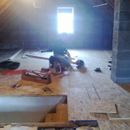Attic finishing & proper insulation
Hello,
I am currently refinishing the attic of my 1955 Cape style house into a new bedroom. The roof joists are 2×6 construction, no vents other than two soffits installed by contractors last year as part of an energy audit. The room is being constructed with knee walls, leaving crawl spaces on either side of the room, and has about 600ft^2 of total ceiling (probably about 400-500ft^2 of living area?) for insulation. We had a relative, who is an architect, draw us up some plans for building and insulating, and now that I’m almost at the insulating stage I’m trying to make sure I understand what’s going on, and minimize cost and potential hazards.
What he suggested we do for insulation was 1 inch of closed cell spray foam, followed by the denser fiberglass batting to fill the rest of the void, and then apply rigid foam board of about 1inch – 1.5 inches over the joists. But after reading a few things here, and on other sites, will this leave me with any moisture control issues? And how will the crawl spaces behind the knee walls affect my moisture control? Do I need to use rigid foam board in the crawl spaces, or could I simply use thicker batting?
Thanks!
Note: the picture I’ve included is pre-framing (we’re about 90% done now), and the knee walls begin approximately where the plywood in the picture ends, if that helps at all.
GBA Detail Library
A collection of one thousand construction details organized by climate and house part










Replies
Eric,
Where are you located? If you want to install a combination of closed-cell foam insulation and fluffy insulation between your rafters to create an unvented insulated roof assembly, your thin (1 inch) closed-cell foam will only work if you live in Climate Zones 1-3. If you live anywhere colder, you need more foam. More information here: How to Build an Insulated Cathedral Ceiling.
For information on insulating the triangular attics behind your kneewalls, see this article: Two ways to insulate attic kneewalls.
Martin,
We're located in Massachusetts, which is Zone 5 I believe.
Thank you for that pdf, its going to be very helpful. I do just have a couple of questions... Does "bringing the attic inside" assume that you have vents under your eves? Or a ridge vent (we have neither, just a couple of those mushroom types in the roof)? When adding space for ventilation between the insulation and the underside of the roof, is that simply a spacer? Or is it directly channeled to a vent (eave of ridge)?
If it makes a difference for what our best method for the knee-wall would be, we do have blown in cellulose insulation in the attic floor already.
Eric,
In your climate zone, the minimum R-value of the closed-cell foam in the type of insulated roof assembly that you are describing is R-20. That means that you need at least 3.5 inches of closed-cell spray foam, not 1 inch.
Here's another link to an article that you may find useful: Creating a Conditioned Attic.
Q. "Does bringing the attic inside assume that you have vents under your eaves? Or a ridge vent?"
A. No. "Bringing the attic inside" means that you are insulating the sloped roof assembly rather than the attic floor. You can create an insulated roof assembly that is either vented or unvented -- it's your choice. That is explained in the article I linked to earlier (How to Build an Insulated Cathedral Ceiling) as well as in the other article ("Creating a Conditioned Attic").
Q. "When adding space for ventilation between the insulation and the underside of the roof, is that simply a spacer?"
A. If you want to create a ventilated roof assembly, you need some type of spacers, as well as some type of material (plywood or cardboard, for example) to separate the top of the insulation material from the air gap. You also need both soffit vents and ridge vents. Again, all of this is explained in the article (How to Build an Insulated Cathedral Ceiling), which I urge you to read before you post more questions.
I apologize for the seemingly redundant questions, I have read the articles, I'm just trying to ensure that I understand what I'm doing 100%.
I've been getting lots of conflicting information, with the architect saying one thing, people talking about this code and that code, and having found out from the inspector that all I really need to do is fill the existing cavity with insulation (perhaps grandfathered in?)
Thank you for being patient.
Eric,
You're right -- you'll hear lots of conflicting information on this topic. I think it's safe to say that building inspectors are an unreliable source of building science information. I wish you good luck on your project.